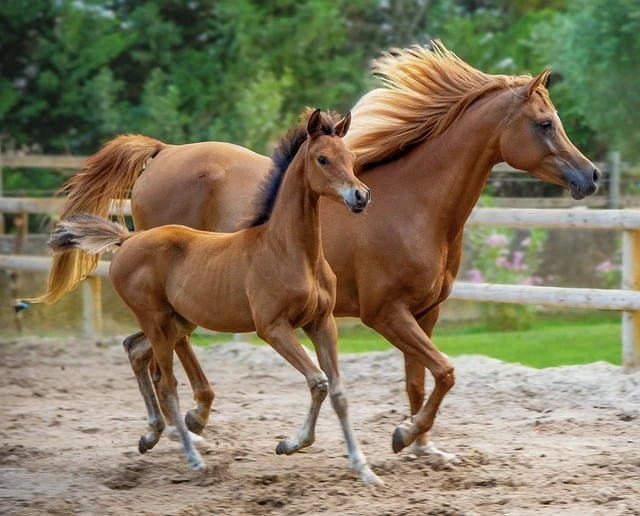Characteristics of Horse
Habitat
Grasslands and domestic environments
Diet
Herbivore - grass, hay, grains
Lifespan
25-30 years
Weight
380-1000 kg
Length
2.1-2.7 m
Region
Worldwide
Horse Sound Characteristics
The horse sound repertoire is rich and expressive, serving as a vital communication system. From the classic horse sound of neighing to subtle nickers, these majestic animals use various vocalizations to express emotions and needs. Understanding horse sound helps appreciate their complex social nature.
Neigh/Whinny
The signature horse sound is a loud, high-pitched call that begins with a squeal and ends with a nicker. This distinctive horse sound can travel considerable distances and serves as a contact call. Horses use this sound to locate herd members or announce their presence. Each horse has a unique neigh sound that others can recognize.
1,000-2,000 Hz
75-90 decibels
1.5-3 seconds
When separated from the herd or greeting other horses
Nicker
A soft, low-pitched horse sound made with the mouth closed. This gentle horse sound expresses anticipation or affection. Horses often produce this sound when expecting food or greeting a familiar human or horse. The nicker is a more intimate horse sound that carries only a short distance but conveys friendly intentions.
500-1,000 Hz
40-60 decibels
1-2 seconds
During feeding time, greeting, or showing affection
Snort
A sharp, explosive horse sound produced by forceful exhalation through the nostrils. This alert horse sound indicates excitement or potential concern. Horses use snorting to communicate alertness to others in the herd. The snorting horse sound is often accompanied by a raised head and alert posture.
300-800 Hz
60-75 decibels
0.5-1 second
When excited, curious, or detecting something unusual
Squeal
A high-pitched, intense horse sound typically produced during confrontations. This warning horse sound signals aggression or establishes dominance. Mares often make this sound to reject stallions or protect their foals. The squealing horse sound is sharp and unmistakable, serving as a clear warning to others.
1,500-2,500 Hz
80-95 decibels
1-2 seconds
During confrontations, establishing dominance, or when threatened
Interesting Horse Sound Facts
The horse sound of neighing can be heard up to 800 meters away in open terrain
Each horse has a unique vocal signature that other horses can recognize
Foals develop their distinctive horse sound within the first two weeks of life
Horses use different sounds depending on whether they're communicating with humans or other horses
The frequency of horse sound can indicate their emotional state and health
Interesting Facts about Horse Sound
Horses can sleep both lying down and standing up
A horse's brain weighs half as much as a human brain
Horses have nearly 360-degree vision
A horse's teeth take up more space in their head than their brain
Horses can read human emotions and remember people's moods
The fastest recorded speed of a horse was 55 mph
FAQs about Horse Sound
Find answers to all your questions about Horse sounds
Q Why do horses neigh?
Horses neigh primarily as a contact call. This distinctive horse sound helps locate separated herd members and announce their presence. The neigh is the loudest horse sound and can travel considerable distances. Horses also use this sound to express excitement, anxiety, or to greet other horses and humans.
Q Can horses recognize each other by their sounds?
Yes, horses can identify individuals by their unique horse sound patterns. Each horse has a distinctive vocal signature that others can recognize, even after long separations. This horse sound recognition helps maintain social bonds and herd structure. Mares and foals particularly rely on recognizing each other's specific horse sound.
Q What sounds do baby horses make?
Foals produce a high-pitched, soft version of adult horse sound. The baby horse sound repertoire includes gentle whinnies and nickers to maintain contact with their mothers. Young horses develop their distinctive sound within two weeks of birth. As they mature, their horse sound gradually deepen and diversify.
Q How do horse sound differ between breeds?
Different horse breeds produce subtle variations in their horse sound. Larger breeds typically create deeper, more resonant horse sounds, while smaller horses and ponies make higher-pitched vocalizations. Draft horses often have louder, more powerful horse sound compared to lighter breeds.
Q Do horses make sounds to communicate with humans?
Horses adapt their sound communication for humans. They often use specific horse sound like gentle nickers to greet familiar people. Horses may produce more frequent or distinctive sounds when they want attention from their human handlers. This targeted horse sound communication shows their social intelligence.
Q What does it mean when a horse snorts?
A horse snort typically indicates alertness or excitement. This sharp horse sound, produced by forceful exhalation through the nostrils, communicates the horse's state of arousal to others. Frequent snorting horse sound during riding may signal the horse is energetic, while snorts in new environments often indicate curiosity.
Q How do wild horses use sounds differently than domestic horses?
Wild horses rely more heavily on their sound communication system. Their horse sounds tend to be more varied and frequent than domestic horses. Wild herds use specific horse sound patterns to coordinate movement and warn of dangers. Domestic horses retain these natural horse sound abilities but may use them less frequently.
Q Can horse sound indicate health problems?
Changes in a horse's normal sound patterns can signal health issues. Unusual horse sound like coughing, labored breathing, or altered vocal quality may indicate respiratory problems. A horse sound that seems painful or occurs during specific movements might suggest discomfort. Regular monitoring of horse sound helps detect potential health concerns early.
Most Downloaded mammals Animal Sounds
Discover our most popular mammals animal sounds
